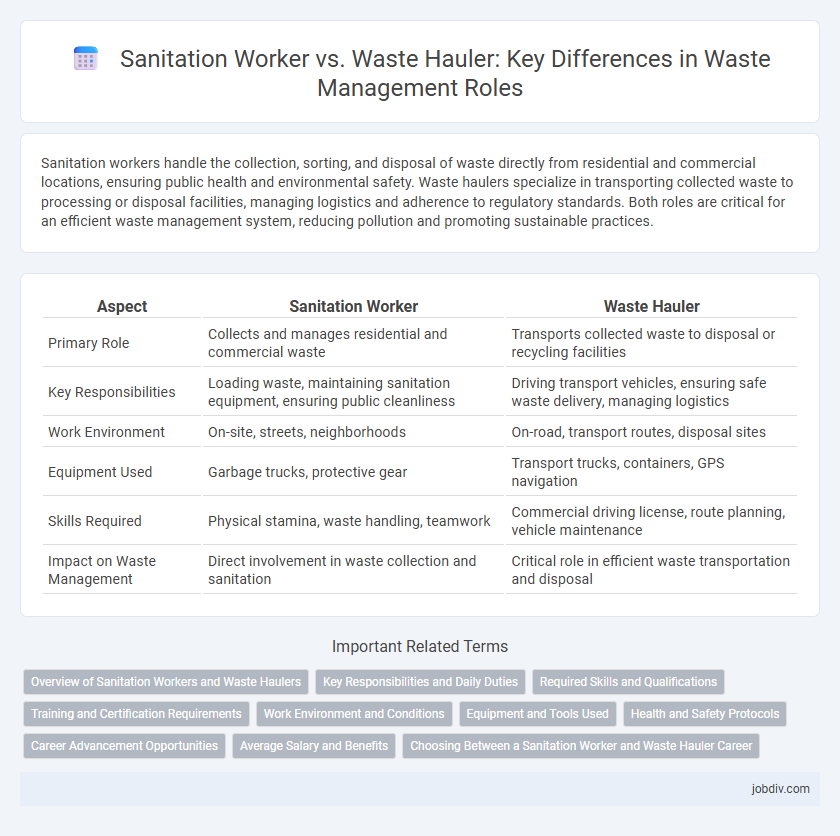Sanitation workers handle the collection, sorting, and disposal of waste directly from residential and commercial locations, ensuring public health and environmental safety. Waste haulers specialize in transporting collected waste to processing or disposal facilities, managing logistics and adherence to regulatory standards. Both roles are critical for an efficient waste management system, reducing pollution and promoting sustainable practices.
Table of Comparison
| Aspect | Sanitation Worker | Waste Hauler |
|---|---|---|
| Primary Role | Collects and manages residential and commercial waste | Transports collected waste to disposal or recycling facilities |
| Key Responsibilities | Loading waste, maintaining sanitation equipment, ensuring public cleanliness | Driving transport vehicles, ensuring safe waste delivery, managing logistics |
| Work Environment | On-site, streets, neighborhoods | On-road, transport routes, disposal sites |
| Equipment Used | Garbage trucks, protective gear | Transport trucks, containers, GPS navigation |
| Skills Required | Physical stamina, waste handling, teamwork | Commercial driving license, route planning, vehicle maintenance |
| Impact on Waste Management | Direct involvement in waste collection and sanitation | Critical role in efficient waste transportation and disposal |
Overview of Sanitation Workers and Waste Haulers
Sanitation workers collect, clean, and dispose of residential, commercial, and public waste to maintain hygiene and public health in communities. Waste haulers transport large volumes of waste from collection points to disposal or recycling facilities, playing a critical role in the waste management supply chain. Both occupations contribute to efficient waste processing, but sanitation workers focus on local waste collection while waste haulers manage the logistics of waste transportation.
Key Responsibilities and Daily Duties
Sanitation workers primarily focus on the collection, sorting, and disposal of waste from residential and commercial areas, ensuring public health and cleanliness. Waste haulers specialize in the transportation and logistics of moving collected waste to recycling centers, landfills, or processing facilities, managing routes and vehicle maintenance. Both roles require adherence to safety protocols and efficient waste management practices to minimize environmental impact.
Required Skills and Qualifications
Sanitation workers require skills in manual labor, knowledge of health and safety regulations, and the ability to operate basic equipment for waste collection and disposal. Waste haulers need commercial driver's licenses (CDL), expertise in vehicle operation, route planning, and customer service to manage transportation of waste to disposal facilities. Both roles demand physical stamina and adherence to environmental and safety standards.
Training and Certification Requirements
Sanitation workers typically require basic safety training, hazardous materials handling, and certification in operating equipment like compactors and loaders. Waste haulers need specialized training in vehicle operation, load securing, and compliance with transportation regulations, often including commercial driver's license (CDL) certification. Both roles emphasize safety protocols and regulatory compliance, but waste haulers face stricter requirements due to transporting waste on public roads.
Work Environment and Conditions
Sanitation workers typically operate in urban and residential areas, often exposed to outdoor weather conditions and handling waste collection directly from households or businesses. Waste haulers drive specialized trucks to transport large quantities of waste to disposal or recycling facilities, spending much of their time on the road with regulated driving hours and safety protocols. Both roles involve physical labor and adherence to hygiene standards, but sanitation workers face more frequent direct contact with waste materials and challenging environmental hazards.
Equipment and Tools Used
Sanitation workers primarily use hand tools such as gloves, brooms, shovels, and garbage bins for manual waste collection, while waste haulers operate heavy machinery including garbage trucks equipped with hydraulic lifts and compactors to transport large volumes of waste. Sanitation workers often rely on protective gear like high-visibility vests and respiratory masks, whereas waste haulers require advanced vehicle control systems and GPS tracking for efficient route management. The difference in equipment reflects the variation in operational scale and physical demands between manual waste collection and mechanized waste hauling.
Health and Safety Protocols
Sanitation workers adhere to stringent health and safety protocols including the use of personal protective equipment (PPE) to minimize exposure to hazardous waste and prevent injury during waste collection and sorting. Waste haulers implement safety measures such as vehicle maintenance checks, proper loading techniques, and compliance with transportation regulations to reduce accidents and ensure safe waste transport. Both roles require ongoing training in waste handling procedures to mitigate risks like contamination, chemical exposure, and ergonomic injuries.
Career Advancement Opportunities
Sanitation workers often start with entry-level responsibilities focusing on waste collection and street cleaning, providing foundational experience crucial for advancing into supervisory or operational roles within municipal or private waste management. Waste haulers typically operate specialized equipment and manage waste transport logistics, positioning them for progression into fleet management, route planning, or safety coordination jobs. Both career paths offer growth with opportunities to earn certifications in hazardous waste handling or environmental compliance, enhancing prospects in the broader waste management industry.
Average Salary and Benefits
Sanitation workers earn an average salary of $30,000 to $45,000 annually, often receiving benefits such as health insurance, retirement plans, and paid leave. Waste haulers typically make between $35,000 and $50,000 per year, with additional perks including overtime pay, performance bonuses, and safety equipment allowances. Both roles contribute to waste management but differ slightly in compensation and benefit packages based on job responsibilities and employer policies.
Choosing Between a Sanitation Worker and Waste Hauler Career
Sanitation workers primarily handle the collection, cleaning, and disposal of waste within communities, often working directly with residential or commercial refuse. Waste haulers focus on transporting large volumes of waste from collection points to disposal or recycling facilities, requiring heavy vehicle operation skills. Choosing between these careers depends on preferences for hands-on waste management versus logistical transportation and the desired work environment, with sanitation workers engaging in field collection and waste haulers emphasizing driving and route planning.
Sanitation Worker vs Waste Hauler Infographic

 jobdiv.com
jobdiv.com